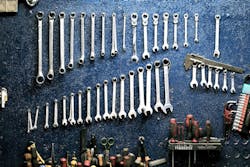You should document the repair today like you’re going to court tomorrow.
It’s a phrase that Frank Terlep repeats often to shop owners, but he still sees operators make mistakes in this area. He’s seen body shops simply not document any of the repair, or miss one or two items that should be documented and included in a bullet-proof file.
Terlep, senior vice president of global innovations for asTech, says that, with the changes in vehicle technology over the past five years and the lessons learned from the 2017 John Eagle lawsuit, body shops need to document every step of the repair and put that documentation into a file—a file that is not only well-built but also, essentially, bulletproof.
David Willet, general manager of the automotive industry for Intrepid Direct Insurance, has spent about 25 years in the industry going to industry events and shops to consult. He says one vital piece of risk management in a shop is building a strong file that has documentation of every step of every repair.
“From a claims perspective, anything can and will be used against you,” Willet says. “It’s important to have people properly trained, like in I-CAR training, and have those people’s work documented at every step along the way.”
Terlep shares five steps for a shop operator to follow to ensure he or she documents the correct information in the correct way.
As told to Melissa Steinken
Step No. 1: Start as early as the pre- and post-repair scan.
A tricky step in the repair process is pre- and post-repair diagnostic scanning. This scan is not something you can easily document on the repair order because it’s done through a separate scanning tool. So, you need to outline what, specifically, you are scanning and what you’re looking for in the scan.
Step No. 2: Document the calibration process, whether it’s in-house or third-party.
Include information like what the OEM repair procedures say should be done in the calibration process. One item that’s often missed in collision repair shops today is documentation of the entire calibration process, because most body shops sublet calibrations to dealerships or a third party. Instead of putting down just one line on a document stating you did the calibration and the scans, write down every detail of the process.
Step No. 3: Take photos of the vehicle at every step.
Photos need to be very specific. For example, often, collision repair technicians only photograph the four corners of a calibration, but the photographs should also include other items. Take photos of the inside of the vehicle to document the internal conditions. Take photos of the trunk, the vehicle’s dashboard mileage, and anything that shows that you have seen and documented the vehicles’ pre-existing condition upon its arrival.
Step No. 4: Include the standard operating procedures used in the repair.
Include the repair procedures that the technicians followed in the bulletproof file. It’s also easier for the shop to document the SOPs used in the repair if the SOPs all have standard names. For example, if the procedure is about how to scan a file, then name the file something along the lines of R1 and then if the procedure is on bringing in the scanning tool, name it R2 and so on.
Anybody receiving the shop’s file and the documentation within it should be able to follow the names of the files. Do not let staff name the files anything they want when they upload it to the shop’s bulletproof file. Also, include the date of the repair procedure. If the procedure changes in following years, there will be proof that the technician followed the most updated procedure of that time.
Step No. 5: If you’re going to store the bulletproof file online, read the software licensing agreement.
No matter what software you are using to store the shop’s documentation, you need to make sure to take time and read the software licensing agreement. This agreement will outline how long the data will be stored for and how much can be stored. Today, storage is cheap, so finding storage through the cloud should not be difficult.
Just be mindful that, in certain programs, stored data might only be stored for a definite period of time, like two years.
Quick Checklist of Items Documented
—
David Willet, general manager of the automotive industry for Intrepid Direct Insurance, outlines a list of the items that shops should include in their bulletproof file:
-
OEM repair procedures
-
Pictures of the car before and after
-
Pictures of the car as it goes through each step of the repair
-
Quality control checklist used in the repair
-
Verification of who performed the calibration and what was done (even if it’s from a third-party)
-
Document the names of the individuals doing the work
-
The dates of the repair




